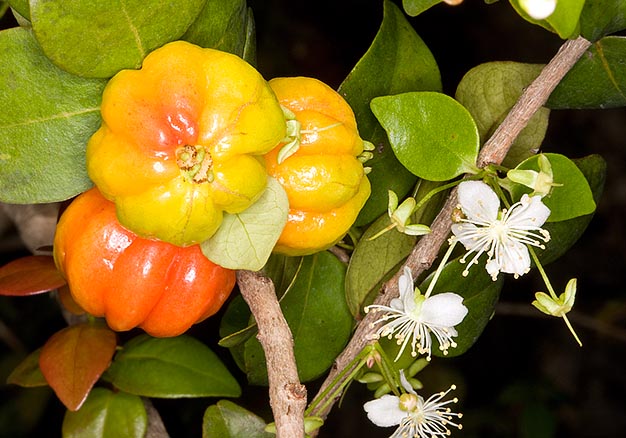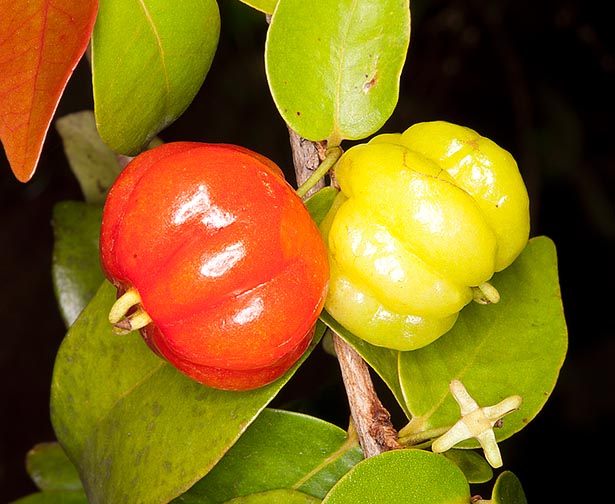Family : Myrtaceae

Text © Pietro Puccio

English translation by Mario Beltramini

Eugenia uniflora can reach the 6-8 m but is usually kept lower in cultivation © Giuseppe Mazza
The genus was honoured to the memory of the general, diplomat and patron, Prince Eugene of Savoy (1663-1736); the name of the species is the combination of the Latin terms “unus, a, um” = one and “flos, oris” = flower, with reference to the not ramified peduncles.
Common names: Brazil-cherry, Florida-cherry, Surinam-cherry (English); cerise à côtes, cerise côtelée, cerise créole, cerisier carré, cerisier de Cayenne (French); ciliegio di Cayenna (Italian); pitanga-da-praia, pitanga-do-norte, pitanga-mulata, pitanga-rosea, pitanga-roxa, pitanga-vermelha, pitangueira, pitangueira branca, pitangueira-do-mato (Portuguese-Brazil); arrayán, cereza quadrada, cerezo de Cayena, cerezo de Surinam, guinda, nagapiry, ñanga-piré, pendanga, pitanga (Spanish); Cayenne-kirsche, Surinam-Kirschmyrte, Surinam-kirsche (German).
The Eugenia uniflora L. (1753) is an evergreen shrub or small tree up to 6-8 m tall, but that in cultivation keeps lower, much ramified, with thick crown and leaves, on 0,2-0,4 cm long petiole, opposite, simple, ovate to ovate-lanceolate with entire margin, 2-5 cm long and 1-3 cm broad, initially of pink bronze colour, then glossy intense green on the upper page, paler below, rather coriaceous and aromatic.
The flowers are axillary, bisexual, solitary or fasciculate on a 1,5-3 cm long peduncle, with persistent calyx having 4 retroflexed lobes about 0,4 cm long, corolla with 4 white obovate petals, about 1 cm long, ephemeral, and with numerous 0,8 cm long stamina. The fruit is a globose berry flattened on the two poles, usually with 8 longitudinal ribs, 1,5 cm long and 2-4 cm broad, initially green, then orange and finally red when ripe, with thin skin and juicy red pulp, sweet to sourish, slightly resinous, usually containing one globose seed, rarely 2-3, of 0,5-1 cm of diameter.
It usually reproduces by seed which has a short-lasting germination capability, one month about, and germinates in 3-4 weeks, with the first flowering after 2-4 years in the best conditions of cultivation, and, to lesser extent, by cutting and air layering.

The fruits are edible and the leaves have medicinal virtues © Giuseppe Mazza
It is the most cultivated of the genus in the tropical and subtropical countries due to the ornamental characteristics, in particular of the foliage, more than for its edible fruits, and the adaptability to a huge variety of soils; fast growing, it is often utilized for fences, even low, and border barriers, as it stands well the prunings, even if drastic.
It is cultivable marginally also in the Mediterranean type climate zones where adult plants can stand temperatures as low as -5 °C for a very short period, with damage of the foliage, taking care to shelter the young plants that get damage at temperatures just below the 0 °C.
It requires a full sun exposition or slight shade, well rooted plants can resist to periods of dry, but with regular waterings the fruits are bigger and less acidulous.
The fruits, quickly perishable, are to be harvested when perfectly ripe, the fresh fruits do have a limited consumption, are often consumed under form of juices, ice-creams, syrups jams and jellies; in Brazil from the fermented juice they get an alcoholic beverage. The leaves are utilized in the traditional medicine; the bark contains about the 20% of tannin, at times used for tanning hides.
Synonyms: Eugenia indica Nicheli (1729); Myrtus brasiliana L. (1753); Plinia rubra L. (1771); Plinia tetrapetala L. (1771); Plinia pedunculata L.f. (1782); Plinia petiolata L. (1785); Eugenia michelii Lam. (1789); Eugenia myrtifolia Salisb. (1796); Eugenia zeylanica Willd. (1799); Myrtus willdenowii Spreng. (1825); Eugenia willdenowii (Spreng.) DC. (1828); Eugenia costata Cambess. (1833); Stenocalyx affinis O.Berg (1857); Stenocalyx brunneus O.Berg (1857); Stenocalyx costatus (Cambess.) O.Berg (1857); Stenocalyx dasyblastus O.Berg (1857); Stenocalyx glaber O.Berg (1857); Stenocalyx impunctatus O.Berg (1857); Stenocalyx lucidus O.Berg (1857); Stenocalyx michelii (Lam.) O.Berg (1857); Stenocalyx oblongifolius O.Berg (1857); Stenocalyx strigosus O.Berg (1857); Syzygium michelii (Lam.) Duthie (1879); Eugenia dasyblasta (O.Berg) Nied. (1893); Eugenia oblongifolia (O.Berg) Nied. (1893); Stenocalyx rhampiri Barb.Rodr. (1903); Eugenia oblongifolia (O.Berg) Arechav. (1905); Eugenia strigosa (O.Berg) Arechav. (1905); Eugenia lacustris Barb. Rodr. (1907); Eugenia microphylla Barb. Rodr. (1907); Eugenia decidua Merr. (1914); Eugenia arechavaletae Herter (1931); Luma arechavaletae (Herter) Herter (1943); Luma costata (Cambess.) Herter (1943); Luma dasyblasta (O.Berg) Herter (1943); Luma strigosa (O.Berg) Herter (1943); Stenocalyx ruber (L.) Kausel (1956); Stenocalyx uniflorus (L.) Kausel (1967); Eugenia oblongifolia (O. Berg) Mattos (1989).
→ To appreciate the biodiversity within MYRTACEAE family please click here.
